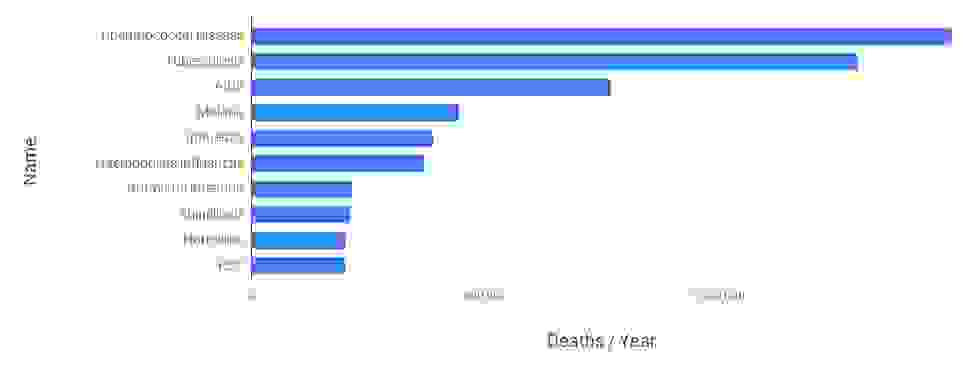The Deadliest Infectious Diseases

All the statistics and news readily available on the Internet has made us all aware of the number of people dying every minute, hour, and day. During the past pandemics, we didn't have online access to such information.
At the moment, the mortality rates are focused on COVID-19. That surely makes most of us worried. How will my family survive? My friends? Lost my job? No income? Live or must die? The depression is here? What changes I have in finding a new job? Will I starve to death? At least a lot of fun in life is now deceased which of course, is an understatement.
Is Nature Out To Kill Us?
However, let's not forget that life surrounded us by deaths long before COVID-19 for many reasons. I sometimes wonder if nature is out to kill us all. The list of likely deadly natural events that can make the human species extinct is a long one. However, due to the genetic diversity of humans, COVID-19 will not be able to make us extinct.
My colleague and I had a long discussion about four months ago about 'stuff' that has the potential to wipe us out. Pandemics will not be able to make us extinct, but the aftermaths might. Why? Because sometimes people themselves are the worst enemy of all humanity.
For example, when it comes to climate change, we must take action before we reach a threshold of no return. Look up the countries that failed COVID-19 response - too late. What followed? A mountain of dead people. We should all participate, make sure we will not be the next lost civilization anytime soon.
It is not about a shortage of energy or shortage of money that is bringing the human race down. It is all about a lack of love.
Nevertheless, this blog focuses on the 'bugs' that love to use us as hosts. I.e., bacteria, and viruses. Once one virologist jokingly said that the meaning of human life is to act as a host for viruses.
Why Is COVID-19 So Scary?
When it comes to COVID-19, we are scared because of the speed it is spreading with, and at the same time, being so contagious. Plus, the incubation period is long, and during that time, many people don't feel sick. Therefore, they can go about their daily activities and unknowingly infect many others. Compare this with a disease that makes people sick fast. People would stay in bed and not infect many others.
The speed of the spread itself is likely to be deadlier than the overall mortality rate. Due to the rapid spreading of COVID-19, healthcare operations are unable to cope with an immense number of patients in a short time. The huge number of patients needing care at the same time results in copious patients unable to obtain adequate care, and thus cause unnecessary deaths.
In Spain, for example, patients were taken off ventilators if they are over 65 years old. The ventilator was the only thing keeping them alive and give hope for recovery.
Prevention? As we have been touted so many times during the current pandemic, the best prevention is good hygiene. Wash your hands, and so on. We all should be familiar with this simple, common-sense advice. Look, for example, in Japan, a country not under lockdown and has managed to control the spread.
| Common Name | Cause | Yearly deaths* |
|---|---|---|
| Pneumococcal Disease | Streptococcus pneumoniae | 1.5 Million |
| Tuberculosis | Mycobacterium tuberculosis | 1.3 Million |
| AIDS (acquired immunodeficiency syndrome) | HIV (Human immunodeficiency virus) | 770,000 |
| Malaria | Plasmodium falciparum | 445,000 |
| Influenza | Influenza virus | 389,000 |
| Haemophilus influenzae Disease | Haemophilus influenzae | 371,000 |
| Severe gastroenteritis - Rotavirus infection | Rotavirus | 215,000 |
| Shigellosis | Shigella (shih-GEHL-uh) | 212,000 |
| Diarrhoeal disease caused by Norovirus | Norovirus | 200,000 |
| Respiratory syncytial virus infection | Respiratory Syncytial Virus (RSV) | 200,000 |
| Total yearly deaths | 5.6 Million |
Compare with the 7.1 million deaths caused by tobacco in 2016.
COVID-19 statistics is here.

Pneumococcal Disease
The most common cause of pneumonia, caused by bacteria Streptococcus pneumoniae.

Tuberculosis
A dangerous bacterial disease affecting lungs caused by Mycobacterium tuberculosis. In Russia, tuberculosis is endemic and an increasing health problem due to the rising incidences of M. tuberculosis strains that are resistant to multiple antibiotics.

AIDS (acquired immunodeficiency syndrome)
Caused by human immunodeficiency viruses (HIV). A well-know disease and will not lead to deaths if treated. However, 38% of HIV-positives in the world are still unable to get medication.

Malaria
Caused by the unicellular protozoan parasite Plasmodium falciparum. Tropical mosquitoes spread the parasite. However, mortality has decreased due to actions financed by the Bill and Melinda Gates Foundation.

Influenza
The cause of this infectious disease is RNA viruses. Both type A and B are the cause of seasonal flu epidemics, but only type A can cause pandemics.
- Influenzavirus A
Aquatic birds are the natural hosts for these viruses, but they can, from time to time, jump to poultry and humans. Influenza A viruses are divided into several serotypes, for example, H1N1 that caused in 1918 Spanish flu and 2009 Swine Flu epidemics. H2N2 caused Asian Flu in 1957, H3N2 caused Hong Kong Flu in 1968, H5N1 caused Bird Flu in 2004.
- Influenzavirus B
Influenza B virus infections are not as common as Influenza A infections due to their slower mutation rate. These viruses may also infect ferrets and seals.
- Influenzavirus C
Influenza C virus infections are not common, and in most cases, only cause mild disease in children. However, these viruses can sometimes cause severe illnesses and can also infect dogs and pigs.
- Influenzavirus D
These viruses infect pigs and cattle. No human infections are known.
See also the Naming Influenza Viruses in the Bulletin of the World Health Organization A revision of the system of nomenclature for influenza viruses: a WHO Memorandum.

Haemophilus influenzae Disease
In the early twentieth century, physicians wrongly believed Haemophilus influenzae bacteria to be the cause of influenza until the viral cause identified (see above).
This bacteria, Haemophilus influenzae, can cause various types of infections. The most common diseases are
- Ear infection
- Inflammation of the joint (infectious arthritis)
- Skin infection (cellulitis)
- Swelling in the throat (Epiglotittis)
- Infection of the spinal fluid (meningitis)
- Bloodstream infection
- Lung infection (pneumonia)

Severe gastroenteritis - Rotavirus infection
Rotavirus infects mostly children and infants, causing diarrhea, vomiting, pain in the stomach, and fever. People of all ages can get infected by rotavirus, but in adults, the disease manifestations are meeker.

Shigellosis
A bacterial infection caused by Shigella bacteria resulting in diarrhea, stomach spasms, and fever, or no symptoms at all. However, people with no symptoms can still infect others.
There are three serogroups of this bacteria Shigella flexneri, Shigella boydii, Shigella dysenteriae, and one serotype, Shigella sonnei.

Diarrhoeal disease caused by Norovirus
Noroviruses are a genetically diverse group of RNA viruses. These viruses are the most common cause of inflammation of the gastrointestinal tract (gastroenteritis), causing diarrhea, vomiting, stomach pain, and sometimes also fever and headache.
Norovirus infections have names, such as food poisoning, stomach flu, stomach, or winter vomiting bug.

Respiratory syncytial virus infection
Caused by Human orthopneumovirus, also known as the Human Respiratory syncytial virus (HRSV, or RSV). These viruses infect the respiratory tract, thereby causing symptoms that are similar to a cold. However, RSV can cause inflammation of the small airways in the lung (bronchiolitis) and infection of the lungs (pneumonia) in less than one-year-old children. RSV infection is potentially severe for infants, but it can also cause severe illness in adults, especially the elderly.
- - -
You may also be interested in the following

This is what coronavirus does to your body
In the beginning, when the viruses enter the body, one does not feel anything. Only after viruses have managed to make enough copies of themselves, and the body’s immune system starts to react, the symptoms of the infection start to show. Read more
Career Outlook: Data and Bioinformatics Scientists to 2026
Degree vs. Skills: Impact on salary
Bioinformatics and data science vacancies
Spicy Food may protect you from cerebral infarction and make you live longer
References
Khalil IA, Troeger C, Blacker BF, et al. "Morbidity and mortality due to shigella and enterotoxigenic Escherichia coli diarrhoea: the Global Burden of Disease Study 1990-2016."[published correction appears in Lancet Infect Dis. 2018 Oct 30;:]. Lancet Infect Dis. 2018;18(11):1229–1240. doi: 10.1016/S1473-3099(18)30475-4
Paget J, Spreeuwenberg P, Charu V, et al. "Global mortality associated with seasonal influenza epidemics: New burden estimates and predictors from the GLaMOR Project."" J Glob Health. 2019;9(2):020421. doi:10.7189/jogh.09.020421
Klenk H, Matrosovich M, Stech J (2008). "Avian Influenza: Molecular Mechanisms of Pathogenesis and Host Range". Animal Viruses: Molecular Biology. Caister Academic Press. ISBN 978-1-904455-22-6.
Centers for Disease Control and Prevention (CDC) and World Health Organization (WHO).
Hay AJ, Gregory V, Douglas AR, Lin YP (2001). "The evolution of human influenza viruses". Philosophical Transactions of the Royal Society of London. Series B, Biological Sciences. 356 (1416): 1861–70. doi: 10.1098/rstb.2001.0999.
